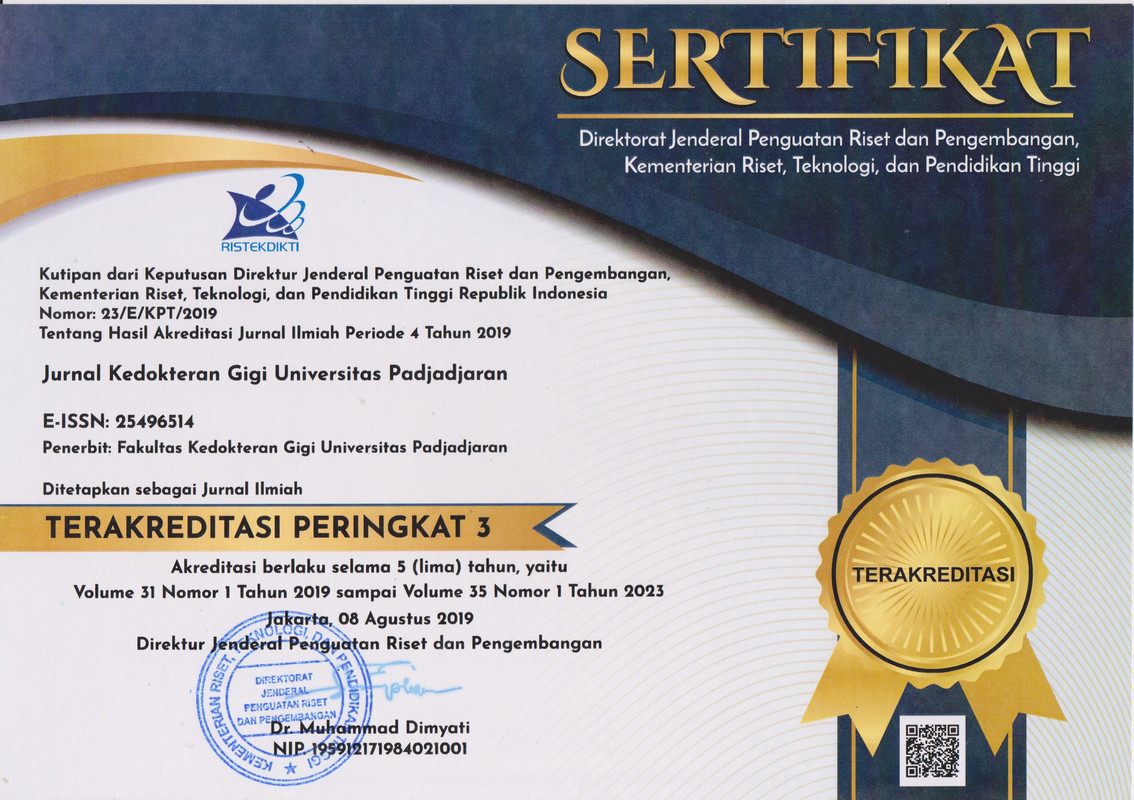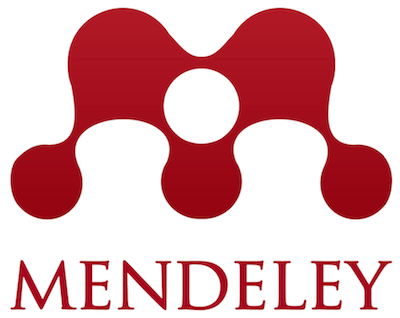Perawatan saluran akar J-shaped pada premolar pertama mandibula: laporan kasus
Abstract
Perawatan saluran akar J-shaped pada premolar pertama mandibula: laporan kasus
ABSTRAK
Pendahuluan: Klinisi harus waspada dengan adanya kelainan pada anatomi internal saluran akar. Pemilihan instrumentasi yang tepat diperlukan untuk preparasi saluran akar melengkung. Kesalahan iatrogenik pada saluran akar melengkung dapat terjadi seperti ledge, separasi instrumen, penyumbatan saluran akar, perforasi, dan transportasi apikal tear-drop. Laporan kasus ini bertujuan untuk menyajikan perawatan endodontik dengan bentuk anatomi saluran akar berbentuk J-shaped. Laporan kasus: Pasien perempuan berusia 52 tahun memiliki keluhan tidak nyaman saat makan. Gigi #34 didiagnosis sebagai nekrosis pulpa. Radiografi awal mengungkapkan lengkungan akar (J-shaped). Preparasi saluran akar dimulai dengan file #8 yang telah dilengkungkan sebagai file awal dan dilanjutkan dengan file rotari gold NiTi (M3-Pro Gold, UDG, Cina) hingga #25/.06 mengikuti kelengkungan saluran akar. Saluran akar J-Shaped dalam klasifikasi Schneider menunjukkan severly curve (29°). Manajemennya dimulai dengan akses lurus ke saluran akar, preparasi dengan k-file kecil dan precurved #08, #10, #15 dengan gerakan push and pull, dilanjutkan dengan file rotary berurutan, bahan kelasi (Ethylenediaminetetraacetic acid/EDTA) digunakan, dan irigasi berulang dengan Natrium hipoklorit (NaOCl). Apikal patensi dilakukan selama cleaning dan shaping untuk menjaga panjang kerja dan mencegah penyumbatan saluran akar. Simpulan: Variasi anatomi saluran akar, teknik instrumentasi, dan obturasi saluran akar penting dipahami guna mencapai keberhasilan perawatan saluran akar pada saluran akar J-Shaped.
Kata kunci
J-shaped canal, perawatan saluran akar, glide path, gold nickel-titanium
Root canal treatment of a J-shaped canal mandibular first premolar: a case report
ABSTRACT
Introduction: Clinicians should be aware of internal anatomical variations. Appropriate selection of instrumentation is essential for preparing curved canals. Iatrogenic errors in curved canals may occur, such as ledge formation, instrument separation, canal blockage, perforation, and tear-shaped apical transportation. The aim of this case report is to present the challenging endodontic management of a mandibular first premolar with a J-shaped canal. Case report: A 52 year-old female patient presented with discomfort while eating. Tooth #34 was diagnosed with pulp necrosis. A pre-operative radiograph revealed root curvature consistent with a J-shaped configuration. Root canal preparation was initiated with precurved file #8 (Dentsply, Switzerland) as initial file, followed by gold NiTi rotary instrumentation (M3-Pro Gold, UDG, China) up to #25/.06, respecting the canal curvature. According to Schneider’s classification, the J-shaped canal showed a severe curvature (29°). Management began with straight access into the canal then prepared with small and precurved k-file #08, #10, #15 with push and pull motion. This was followed by rotary file sequencing. A chelating agent (EDTA) and copious irrigation with sodium hypochlorite were employed. Apical patency was maintained throughout cleaning and shaping to preserve the working length and prevent canal blockage. Conclusion: Knowledge of root canal anatomy, together with appropriate instrumentation materials and techniques, is crucial to achieving successful root canal treatment.
Keywords
J-shaped canal, endodontic treatment, glide path, gold nickel-titanium
Keywords
Full Text:
PDFReferences
DAFTAR PUSTAKA
Parashar SR, Kowsky RD, Natanasabapathy V. Mandibular second molar exhibiting a unique “Y-” and “J-” “shaped” root canal anatomy diagnosed using cone-beam computed tomographic scanning: A case report. J Conserv Dent. 2017;20(1):50-
https://doi.org/10.4103/0972-0707.209074
Balani P, Niazi F, Rashid H. A brief review of the methods used to determine the curvature of root canals. J Res Dent. 2015;3(3):57-63. http://dx.doi.org/10.4103/2321-4619.168733
Chowdhury K, Das M, Das U, Biswas M. Endodontic management of severely curved root canal systems – case reports. J Dent Med Sci. 2024;23(7):22-7. https://doi.org/10.9790/0853-2307112227
van der Vyver PJ, Vorster M, Paleker F, de Wet F. Root canal preparation: A literature review and clinical case reports of available materials and techniques. S Afr Dent J. 2019;74(4):187-99. https://doi.org/10.17159/2519-0105/2019/v74no4a4
Patnana AK, Chugh A. Endodontic management of curved canals with protaper next: a case series. Contemp Clin Dent. 2018;9(Suppl 1):S168-72. https://doi.org/10.4103/ccd.ccd_54_18
Dhaimy S, Dhoum S, Diouri M, Bedida L, Elmerini H, Benkiran I. Cone-beam computed tomography evaluation of the root morphology of the maxillary and mandibular premolars in a Moroccan subpopulation: canal configurations and root curvatures (Part 2). Saudi Endod J. 2021;11(2):162-7. http://dx.doi.org/10.4103/sej.sej_77_19
Rachmawati CA, Muryani A. Perawatan gigi premolar kedua rahang atas dengan saluran akar bengkok menggunakan jarum NiTi rotary. J Ked Gigi Universitas Padjadjaran. 2020;32(2):17-25. https://doi.org/10.24198/jkg.v32i2.27397
Sahay S, Raj S, Nikhil V. Management of root canal curvatures and review. Indian J Conserv Endod. 2023;8(2):69-73. http://dx.doi.org/10.18231/j.ijce.2023.013
Nagy CD, Szabó J, Szabó J. A mathematically based classification of root canal curvatures on natural human teeth. J Endod. 1995;21(11):557-60. https://doi.org/10.1016/s0099-2399(06)80985-4
Nugroho JJ, Utami AP. Apical patency as a way of preserving the apical third area of endodontic treatment. Makassar Dent J. 2020;9(3):181-3. DOI 10.35856/mdj.v9i3.350
Yen CSA, Sawant K, Pawar AM. Significance of apical patency in endodontics: a narrative review. Dentistry. 2021;11(3):1-3.
Mohammadi Z, Jafarzadeh H, Shalavi S, Kinoshita JI. Establishing apical patency: to be or not to be? J Contemp Dent Prac. 2017;18(4):326-9. https://doi.org/10.5005/jp-journals-10024-2040
Mahardiansyah R, Tri R, Untara E, Nugraheni T. Endodontic treatment of complex curved root canal maxillary caninus: a case report. Proceedings of 1st Aceh International Dental Meeting. 2021;32:81-4. http://dx.doi.org/10.2991/ahsr.k.210201.018
Mittal R. Endodontic management of curved canals in mandibular molars- a case series. Int J Oral Health Dent. 2023;9(1):48-51. http://dx.doi.org/10.18231/j.ijohd.2023.009
Vachhani K, Kachoriya K, Kubavat R, Bagda K, Attur K, Patel S. Reshaping the curves for successful endodontic treatment: a case series. Int J Adv Res.2020;8(7):1075-9. https://dx.doi.org/10.21474/IJAR01/11370
Ansari I, Maria R. Managing curved canals. Contemp Clin Dent. 2012;3(2):237-41. https://doi.org/10.4103/0976-237X.96842
Bansode P, Wavdhane MB, Pathak SD, Khedgikar SB, Rana H. Evolution of rotary Ni-Ti file systems: a literature review. Indian J Appl Res. 2016;6(12):91-4.
Tabassum S, Zafar K, Umer F. Nickel-Titanium rotary file systems: what’s new?. Eur Endod J. 2019;4(3):111-7. https://doi.org/10.14744/eej.2019.80664
Jafarzadeh H, Abbott PV. Ledge formation: review of a great challenge in endodontics. J Endod. 2007;33(10):1155-62. https://doi.org/10.1016/j.joen.2007.07.015
Dhamayanti I, Nugraheni T. Restorasi fiber reinforced composite pada gigi premolar pertama mandibula pasca perawatan saluran akar. Maj Ked Gigi Indonesia. 2013;20(1):65-70. https://doi.org/10.22146/majkedgiind.8382
Natalia D, Kristanti Y. Composite resin restoration with fiber reinforced composite after root canal treatment of necrotic pulp tooth with gumboil. J Teknosains. 2021;10(2):103-10. https://doi.org/10.22146/teknosains.41113
Mangoush E, Garoushi S, Lassila L, Vallittu PK, Säilynoja E. Effect of fiber reinforcement type on the performance of large posterior restorations: a review of in vitro studies. Polymers (Basel). 2021;13(21):1-12. https://doi.org/10.3390/polym13213682
DOI: https://doi.org/10.24198/jkg.v37i1.49843
Refbacks
- There are currently no refbacks.
Copyright (c) 2025 Jurnal Kedokteran Gigi Universitas Padjadjaran
INDEXING & PARTNERSHIP

Jurnal Kedokteran Gigi Universitas Padjadjaran dilisensikan di bawah Creative Commons Attribution 4.0 International License






.png)

















